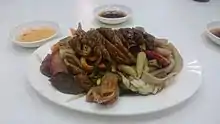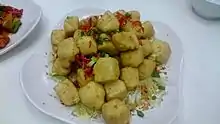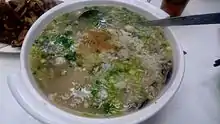Daa Laang
Daa laang (Chinese: 打冷; Jyutping: daa2 laang1) refers to a nighttime meal in Hong Kong cuisine. First emerging in the 1950s, it includes hot and cold Chaozhou dishes.
Origins
Daa laang originated from Chaozhou. Therefore, it is also called Chaozhou daa laang, which refers to the popular cold cuts and hot dishes from the food stalls in Chaozhou. Marinated food, seafood, pickled products and cooked dishes are the four main types of daa laang. It was then spread into Hong Kong by immigrants from Chaozhou in the 1950s. The traditional way to order the food is to choose the dish of choice in front of a waiter who would then, mark them down for customers. Your daa laang would then be made and sent to your table. Daa laang food would then be made and sent to their table. Because of daa laang's convenience and unique taste, the traditional dish is fast expanding into other parts of the country including Shenzhen.[1]
Etymology
The term originated from Hong Kong, which was created in Cantonese.
Literal connotation
- In fictions of the Song dynasty and Yuan dynasty, terms such as “da tsim” (Chinese: 打尖; Jyutping: daa2 zim1) and “da dim” (Chinese: 打店; Jyutping: daa2dim3), reference going to a restaurant for dinner while travelling. Hence, the word “daa” can refer to eat at a restaurant.[2]
- In the Teochew dialect, the word “lang” means "people." Thus, Cantonese refer to the Teochew people as “lang lo” (Chinese: 冷佬; Jyutping: laang5 lou2). Over time, "lang lo" became a slang term, in reference to Chaozhou food stalls.[3] Then gradually the term daa laang referenced dinner at Hong Kong’s Chaozhou stalls.
Influence of Teochew dialect
- In the 1950s, there were many Teochew people selling late-night supper and marinated food at Hong Kong’s streets. They used to carry baskets with poles on their shoulders, and then peddled along the streets. They were called as the “basket carriers”. The pronunciation of this term in Chaoshan is similar to “daa laang”, so then Hong Kong people call them the daa laangs. In the course of time, “daa laang” became the term that represents eating Teochew cuisine in Hong Kong.[4]
- Besides, at that period, many gangs dined and dashed at the Chaozhou stalls, then a Chaozhou gang was formed in Hong Kong to show the Chaozhou’s solidarity. Once they found someone who came for a meal, they would yell “hit them!” to gather near-by fellows, so as to deal with these people. “daa laang” in Teochew dialect means "hit them", thus gradually people related daa laang and Chaozhou cuisine together.[5]
Dishes




One must-have item for Hong Kong people to go daa laang is called the marinated or the Chaozhou soy-sauce goose. The marinated sauce is adjusted by every top chef in the daa laang so there is a slight difference between every daa laang. People usually order marinated tofu and cuttlefish together with the goose or directly order a marinated combination to taste the effort by the chef.
Another item that daa laang is famous for is the pepper and salt fried food. Daa laang usually use some light food like tofu and squid to cook with. Chef will first fry the particular food and then re-fry it with pepper and salt, and serve with chili to create a spicy and salty dish.
People will also order both hot and cold food from daa laang, which is usually cheaper food than the food served in formal Chaozhou restaurant. For hot items, it includes oyster congee, which also adds chopped meat and dried flatfish into the congee; pan fried oyster cake, adding oyster meat into egg and fry; lemon flathead mullet, adding lemon pieces into the mullet and steam; Chinese kale and beef served with special Satai sauce, in which the satai sauce is unique in daa laang.
For cold items, people will order iced cockle, which the chef will boils the cockle and freeze it, then serve it with a special sauce made with garlic, sugar and vinegar; and iced crab, the chef steams the live-crab with cold water until it is boiled.
Opinions
Having congee with daa laang already become a popular trend of supper among Hong Kong people since 1950s. People love socializing and gathering at the Chaozhou restaurant or Dai Pai Dong after working for the whole day as the dishes are very common and affordable-a bowl of Chaozhou congee only cost a few cents of Hong Kong dollars in the past.[6] The old and well-known daa laang restaurants provide good service and the waiters usually wear smile as they have already worked for many years and built a close relationship with customers.[7]
References
- "潮汕美味大搜索", Retrieved 18 June 2012
- " 字詞溯源:「打冷」起源", Retrieved 1 June 2004
- http://hk.apple.nextmedia.com/supplement/food/art/20130307/18186576
- "粵港澳生活圈:港「潮」人深穗「打冷」吃家鄉味", Retrieved 9 January 2015
- "潮汕美味大搜索", Retrieved 18 June 2012
- "Q 之二釐館". q2kill.blogspot.hk.
- shukudon. "Chong Fat Chiu Chow Restaurant – Chiu Chow Chinese Restaurant in Kowloon City Hong Kong – OpenRice Hong Kong". openrice.com.